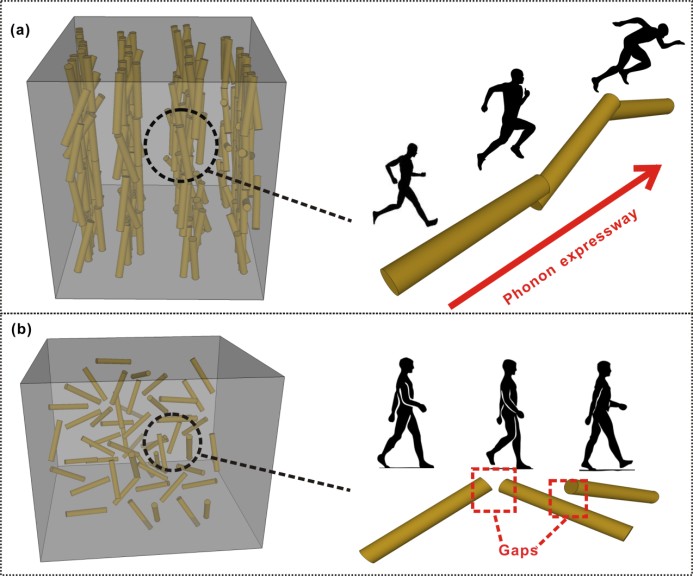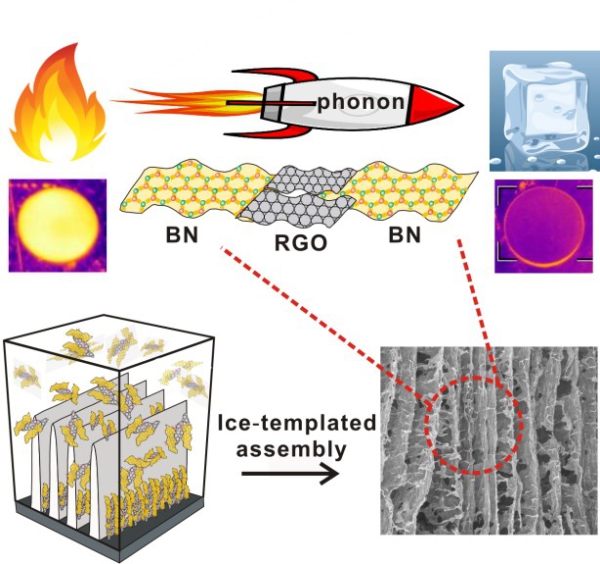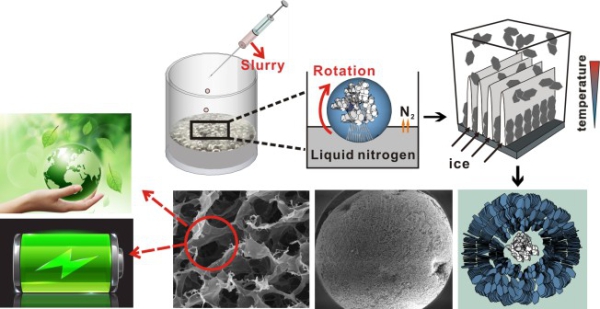Researchers Developed A Series of Novel Thermally Conductive Polymer Composites
Date:22-05-2018 | 【Print】 【close】
Efficient thermal dissipation has become a stringent necessity in miniaturized electronic and photonic devices for longer lifetime and higher speed. Thermally conductive materials are believed to be the best choice to help address the heat-removal issue.
Usually, thermally conductive materials are composed of thermally conductive fillers and a polymer matrix. However, enhancement of thermal conductivity (K) for the polymer composites with disorderly dispersed fillers is limited due to the lack of efficient thermal transfer pathways. Therefore, it remains a challenge to achieve high efficiency of K enhancement at low filler loading.
Professor SUN Rong, working at the Center for Advanced Materials, Shenzhen Institute of Advanced Technology, Chinese Academy of Sciences, developed a series of novel thermally conductive polymer composites.
3D SiCNW/epoxy composites with an ultrahigh efficiency of thermal conductivity enhancement were successfully prepared by constructing a simultaneously aligned and interconnected structure of SiCNWs via freeze casting. At a small filler loading of 2.17 vol %, the through-plane thermal conductivity of SiCNW/epoxy composite reaches 1.67 Wm-1K-1, enhanced by 400.6% per 1vol% loading when compared with pure matrix, performing the highest value of efficiency among previously reported thermally conductive and electrically insulating composites. The paper with a title "Vertically Aligned and Interconnected SiC Nanowire Networks Leading to Significantly Enhanced Thermal Conductivity of Polymer Composites" was published in ACS Applied Materials & Interfaces on February, 2018.
On the basic of 3D SiCNW network, the research team also put forward another filler network for efficient heat transferring. BN and graphene which share silimar phonon spectra were applied to construct 3D skeletons. A unique thermal reinforcement effect of rGO was demonstrated and investigated in BN-based 3D skeletons. An ultrahigh through-plane thermal conductivity up to 5.05 Wm-1K-1 was demonstrated by the 3D BN-rGO/epoxy composite. The entitled paper, "Construction of Three-dimensional Skeleton for Polymer Composites Achieving a High Thermal Conductivity", was published in Small on February, 2018.
Due to the complicated operation and lack of potential for large-scale production, ice-templated assembly as a strategy to fabricate polymer composites with aligned filler hardly provide support for industial application. Thus, Professor SUN Rong further developed a faciel strategy to fabricate 3D spongy sphere as thermally conductive filler, in which ice-templated assembly and liquid nitrogen-assisted rotation are coupled, for fast processing of uniform spongy millispheres with tunable microstructures. Such spheres possess a hierarchical structure with an interpenetrating, open-porous, urchin-like network and abundant external voids, which can be continuously fabricated on a large scale by employing automatic propeller. The strategy shows huge potential in themal-management area. The paper named "Liquid nitrogen driven assembly of nanomaterials into spongy millispheres for various applications" was published on Journal of Materials Chemistry A on February, 2018.
This work is supported by the Major National R&D Projects, National Key R&D Program of China, Frontier Sciences Key Research Program of the Chinese Academy of Sciences, and Guangdong Provincial Key Laboratory.

Figure 1. Thermal conduction model of 3D SiCNW network (Image by Professor SUN Rong)

Figure 2. Thermal conduction model of 3D BN-graphene network (Image by Professor SUN Rong)

Figure 3. A novel strategy for fabrication of 3D spongy sphere for various applications (Image by Professor SUN Rong)
CONTACT:
ZHANG Xiaomin
Email: xm.zhang@siat.ac.cn
Tel: 86-755-86585299